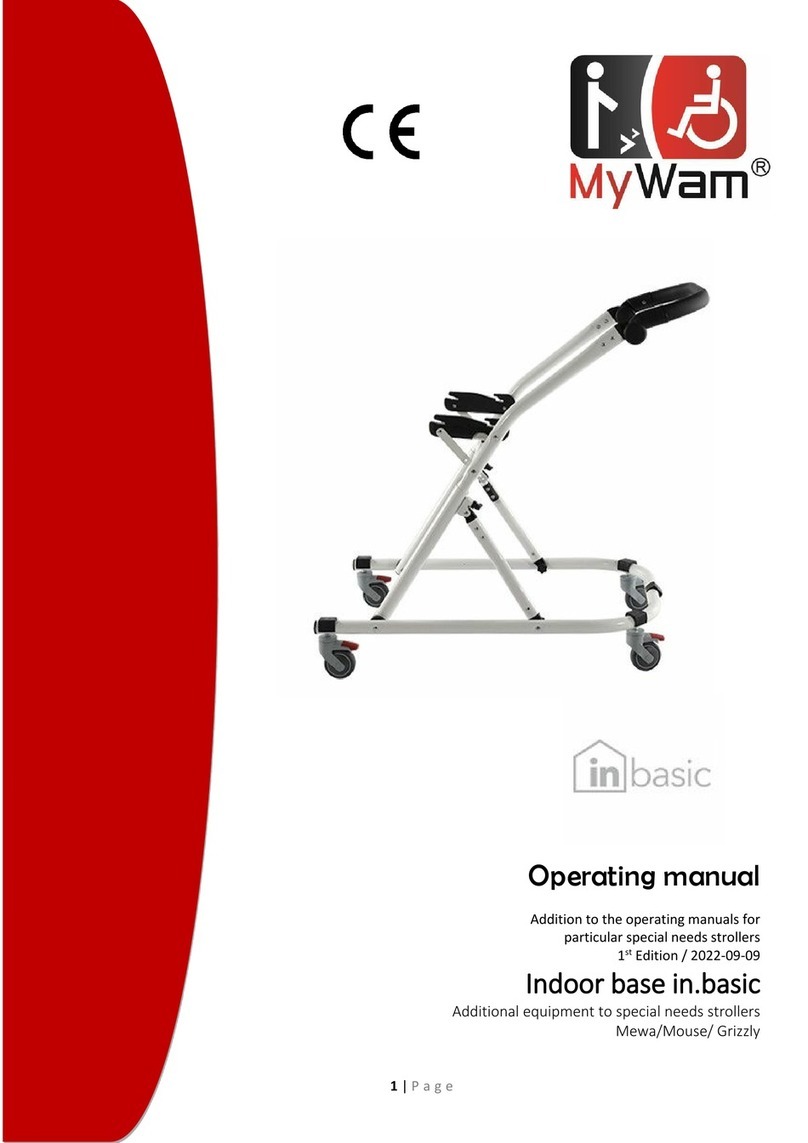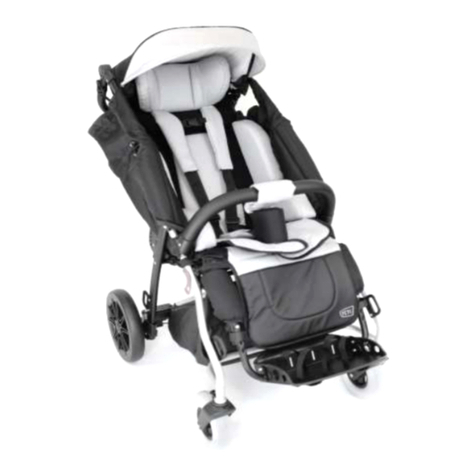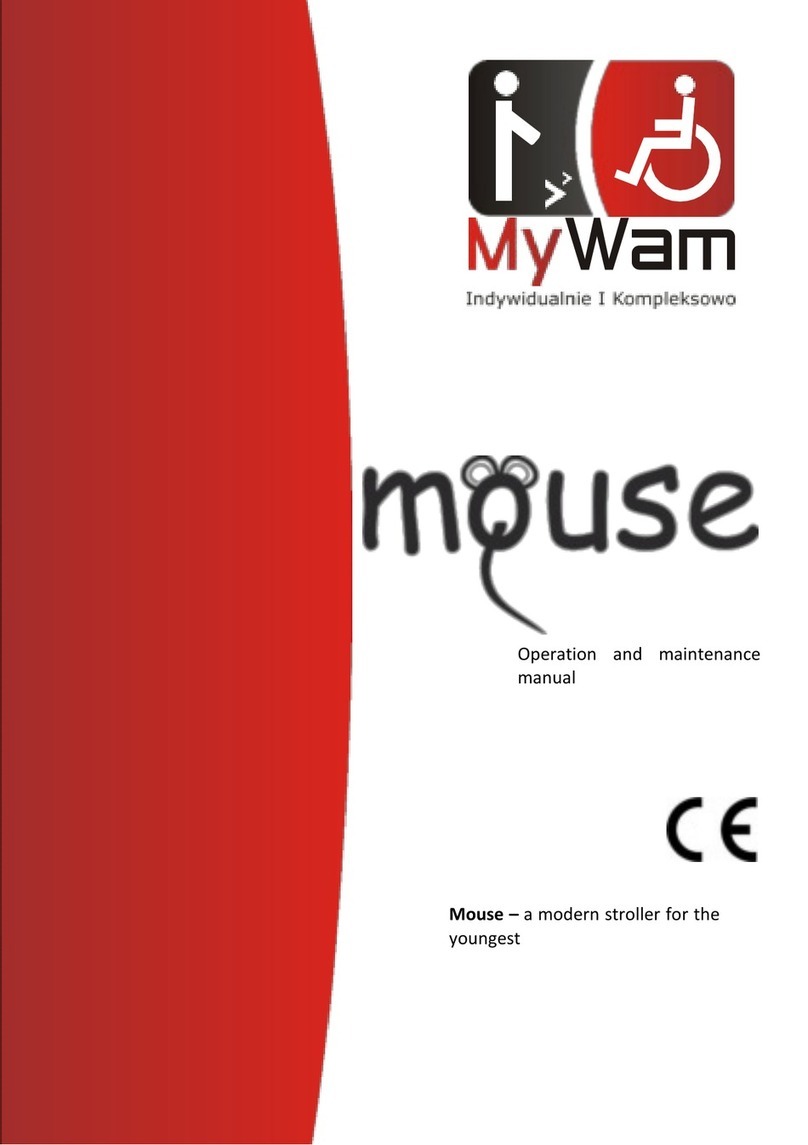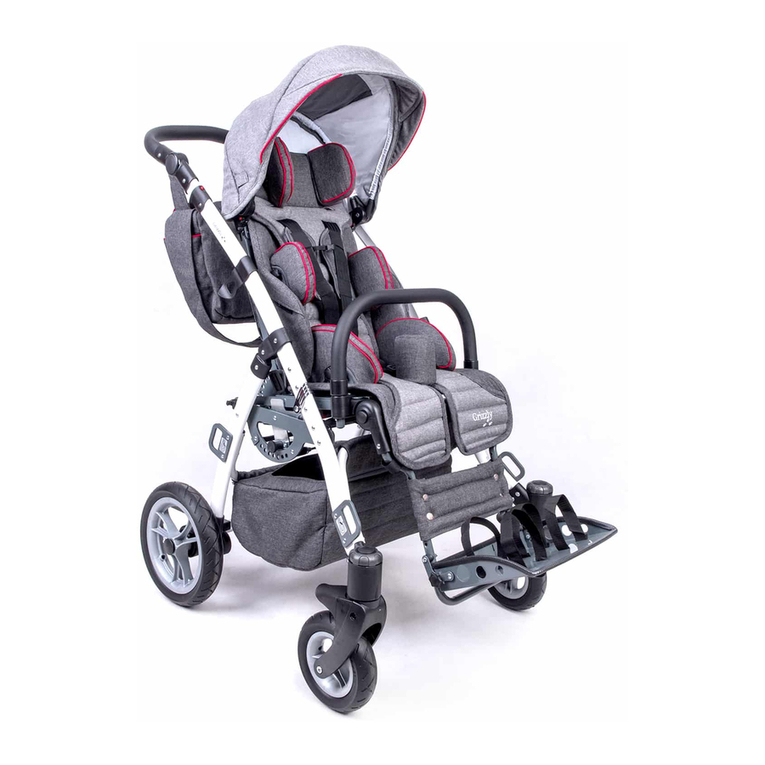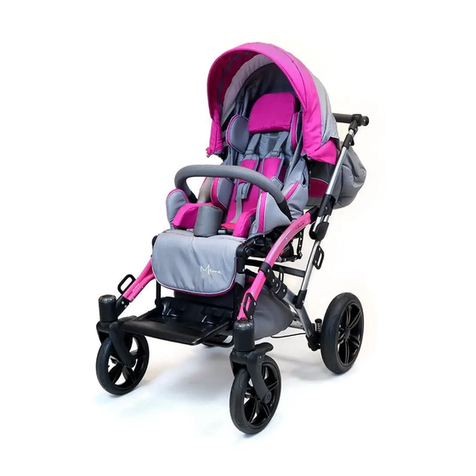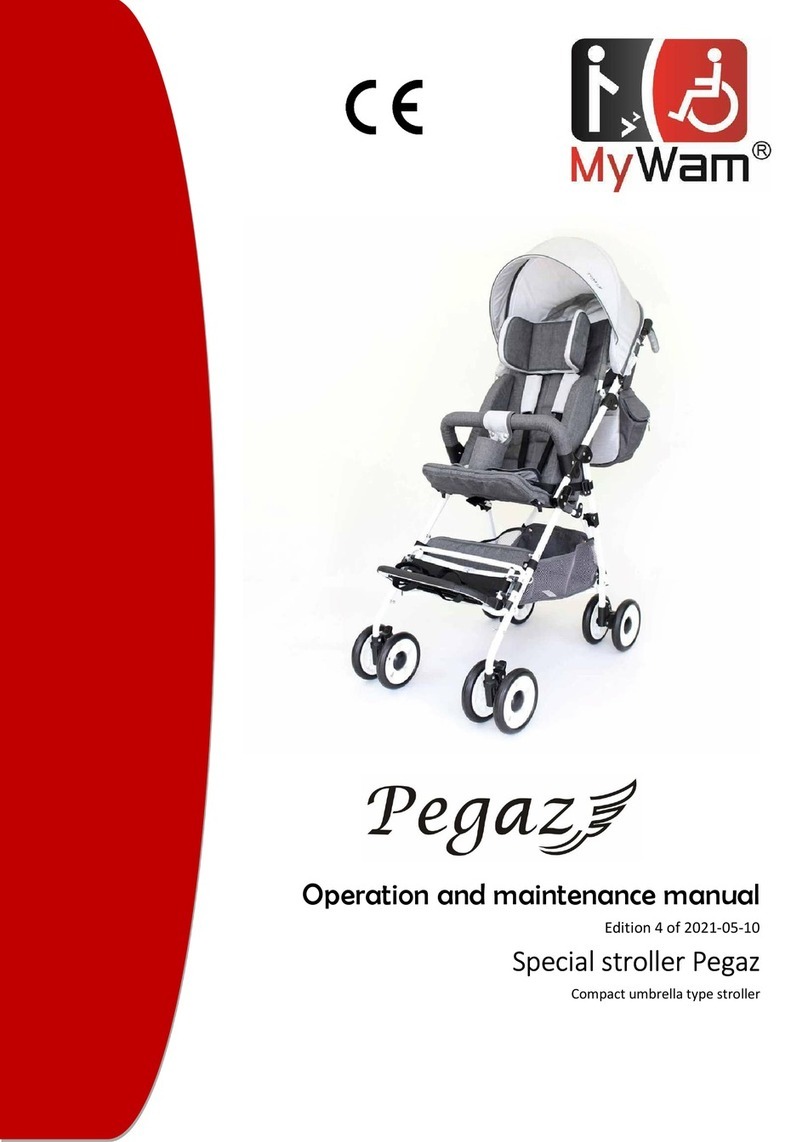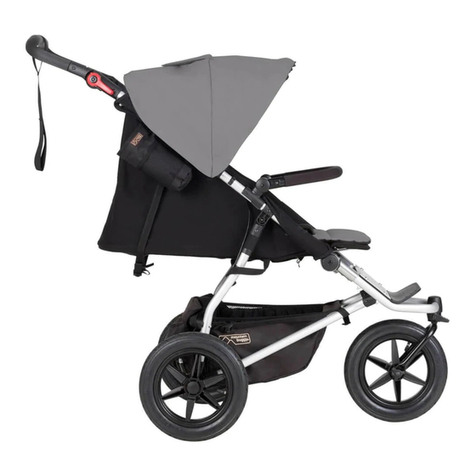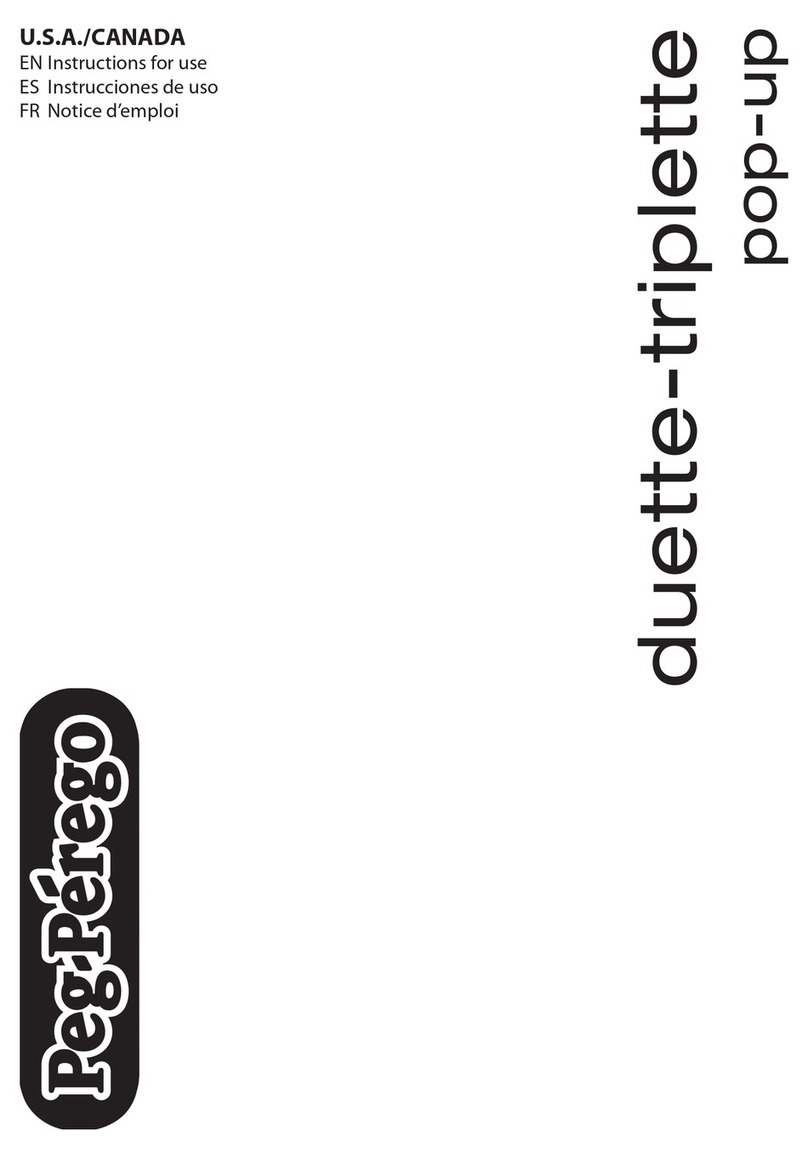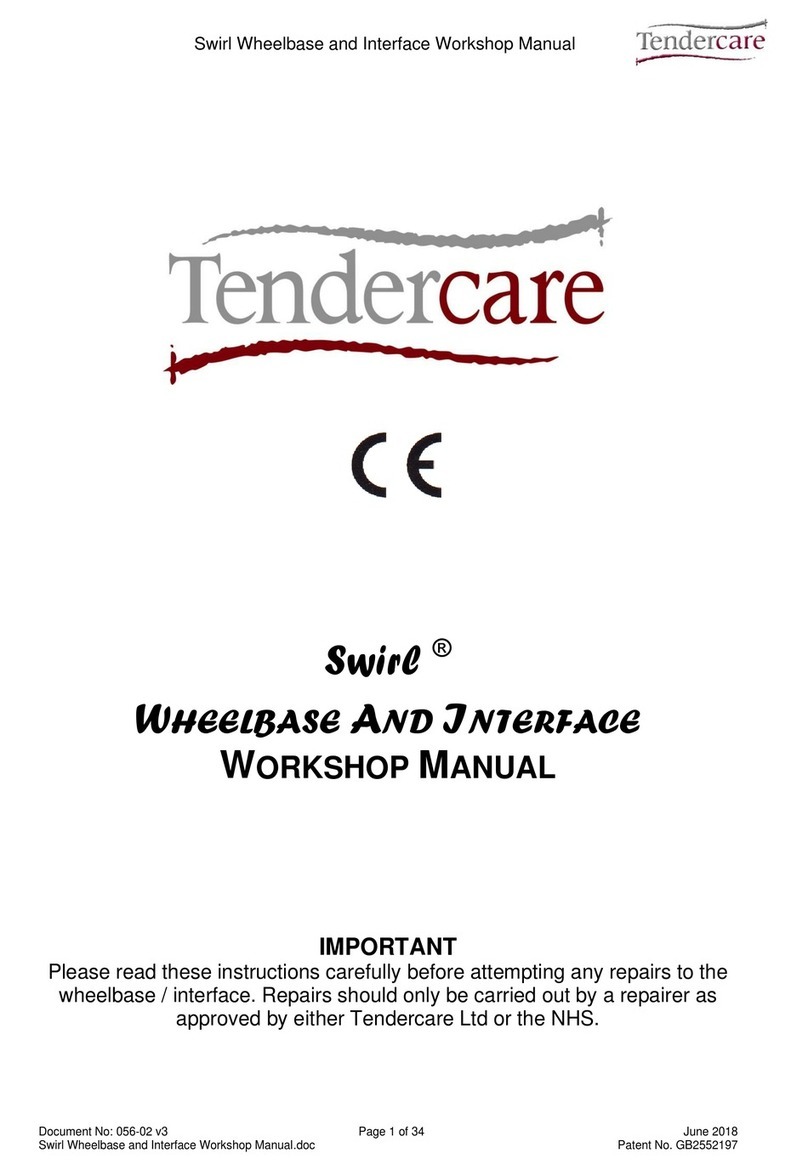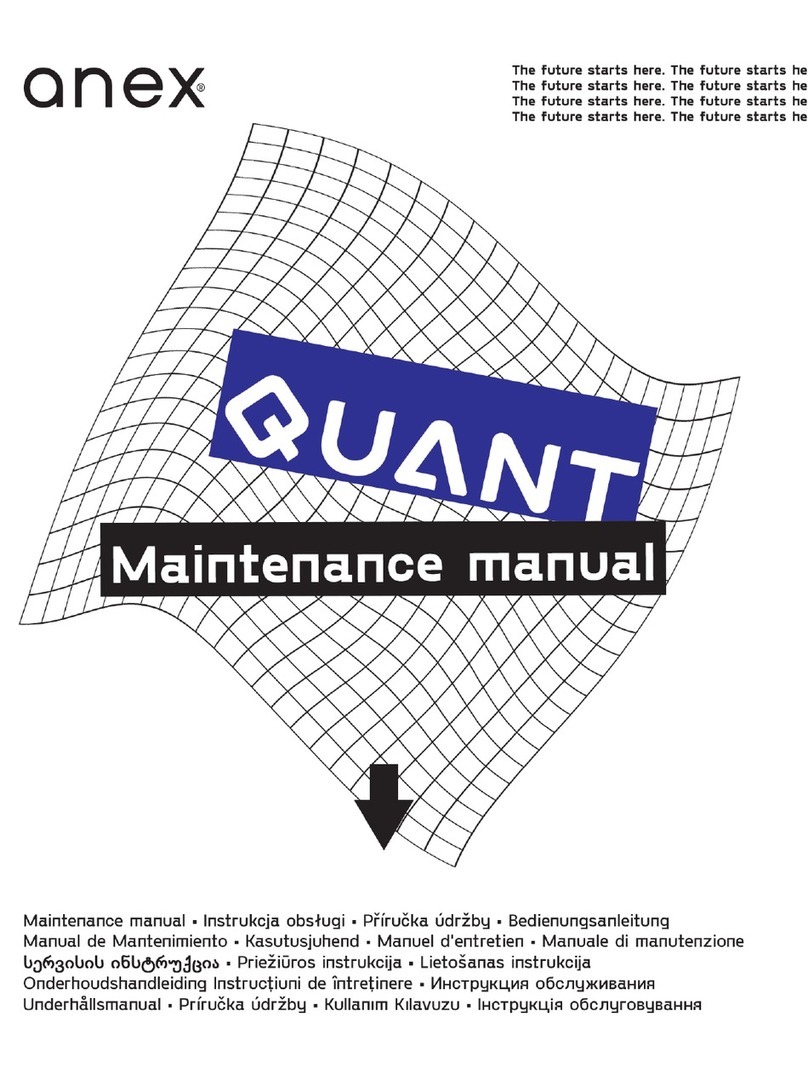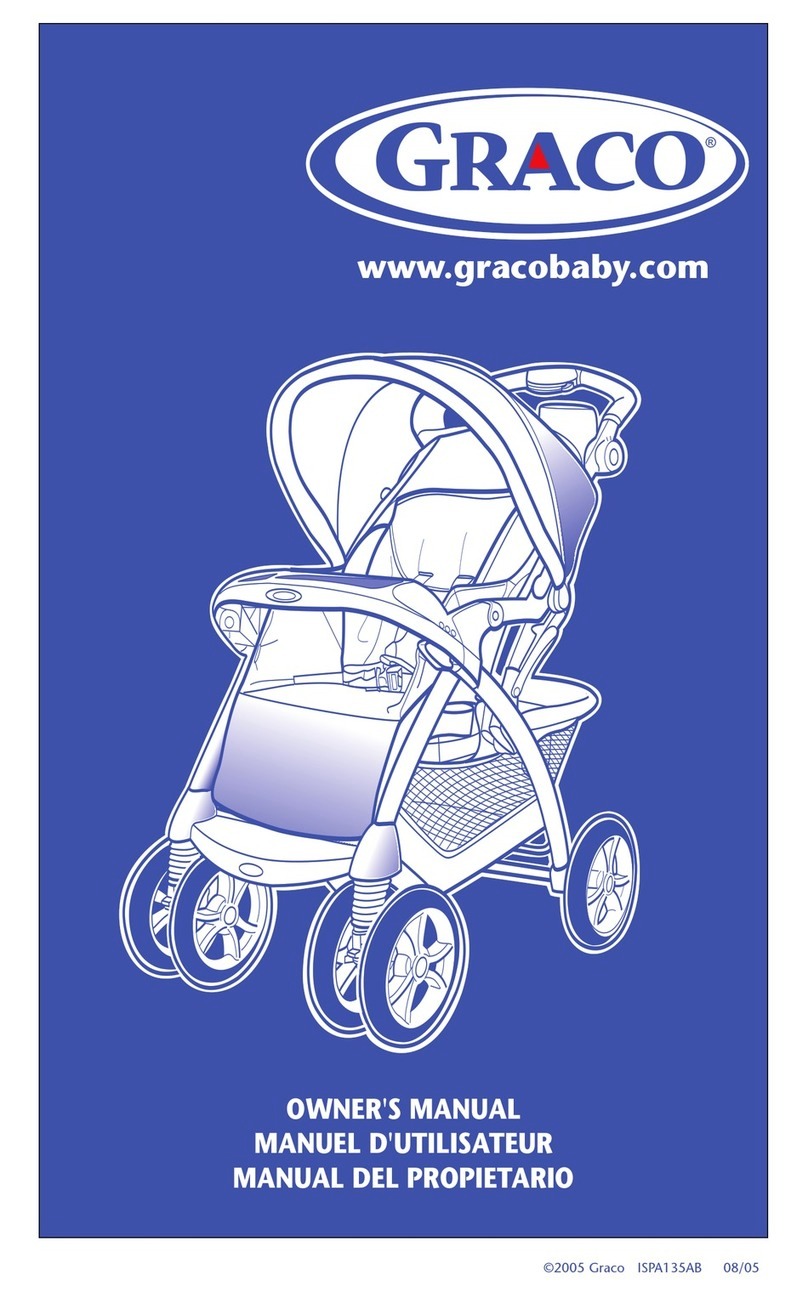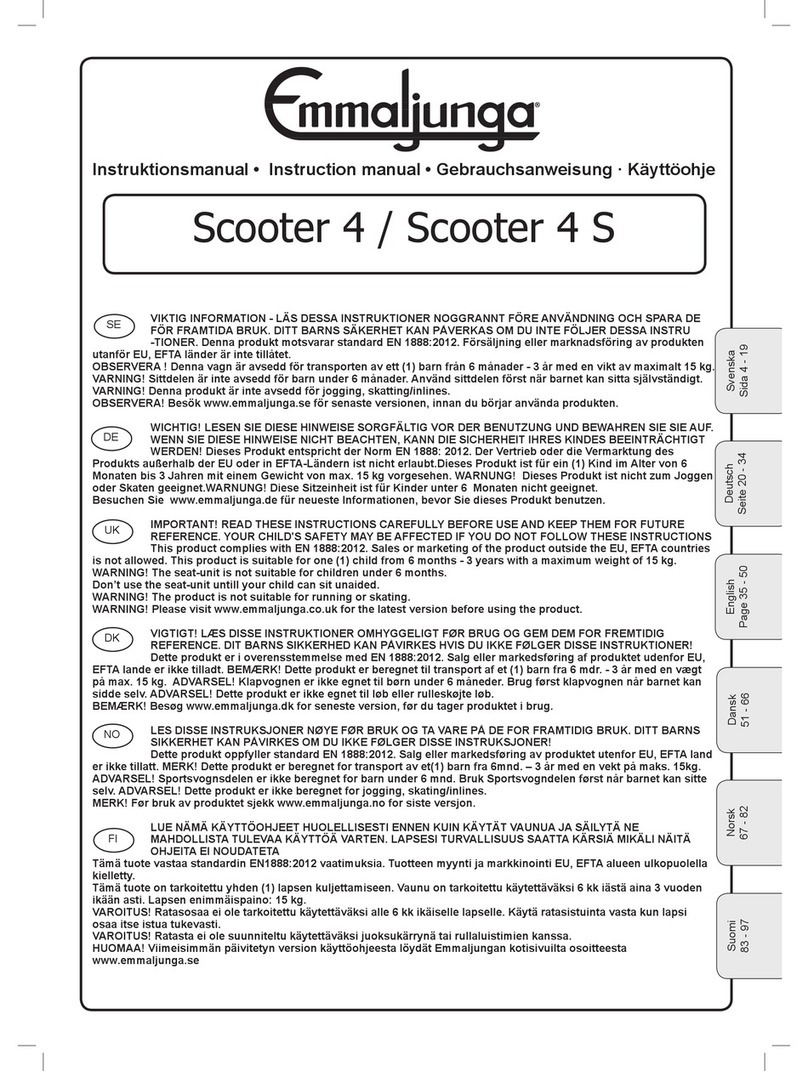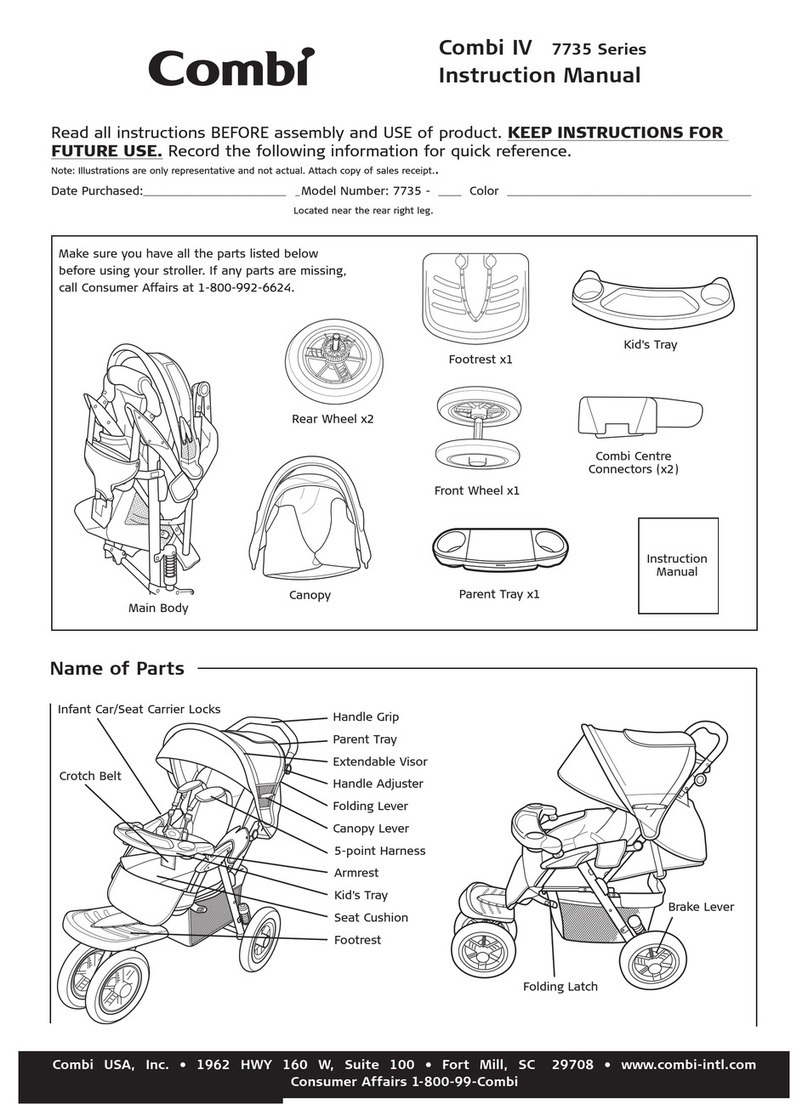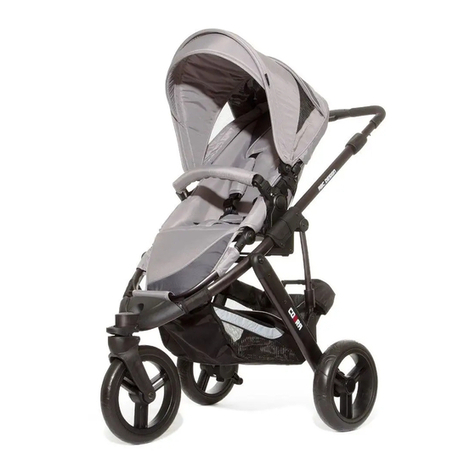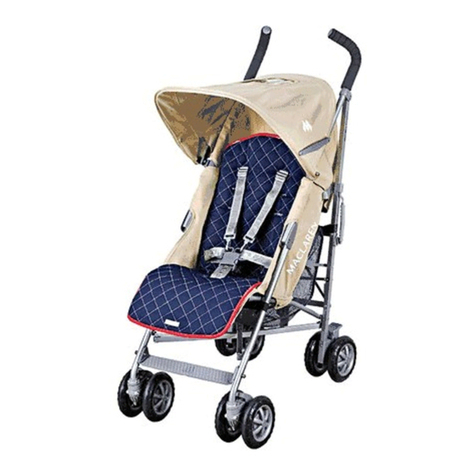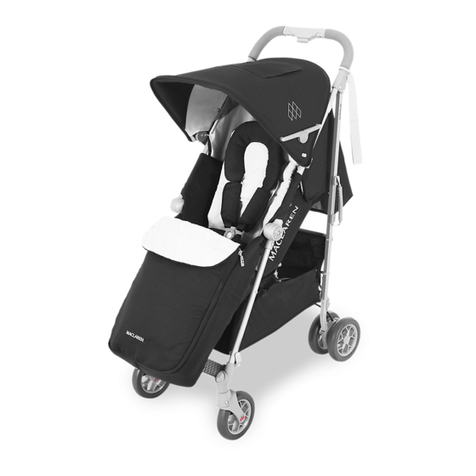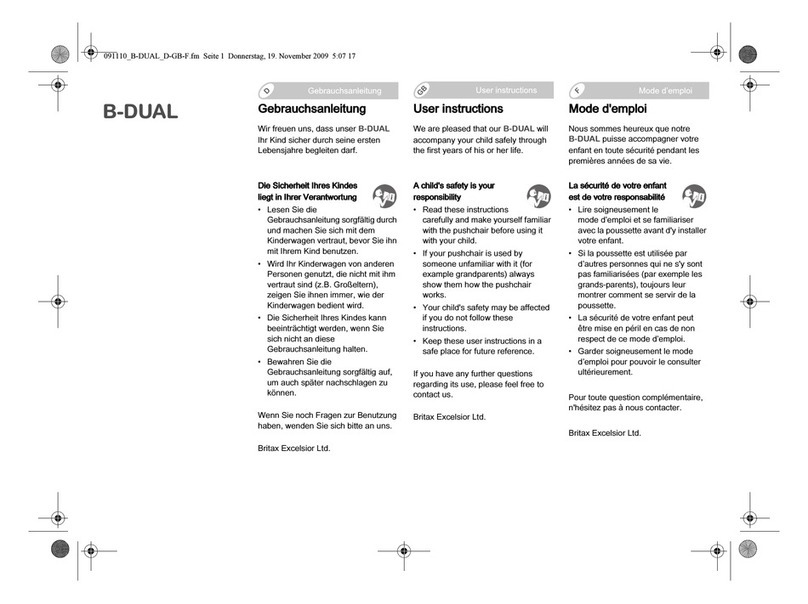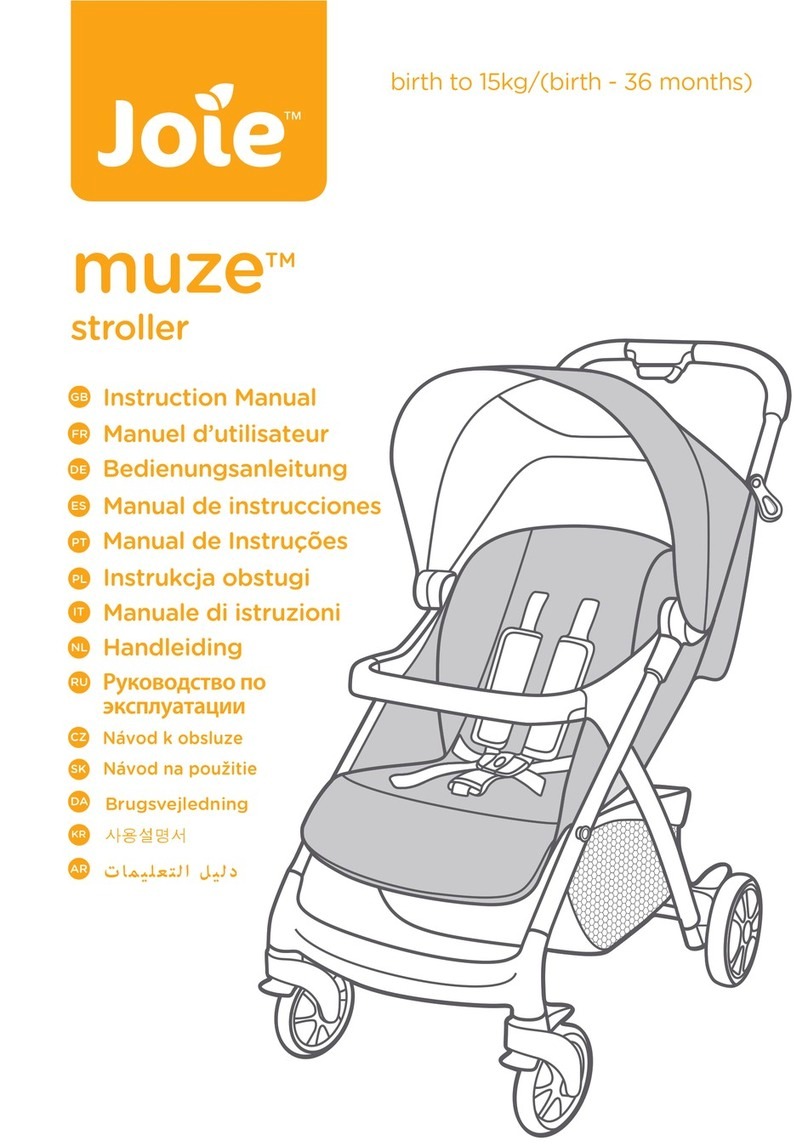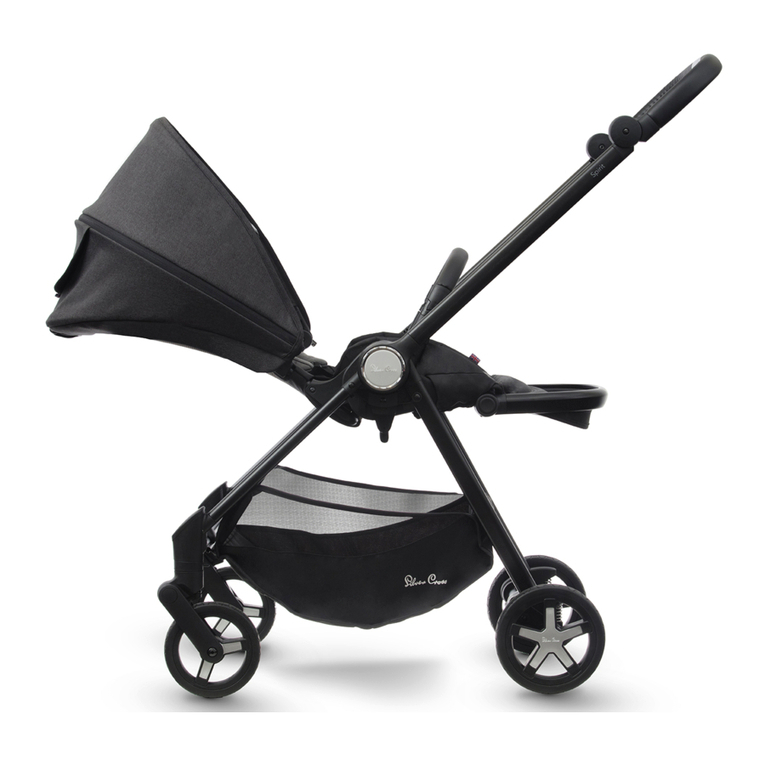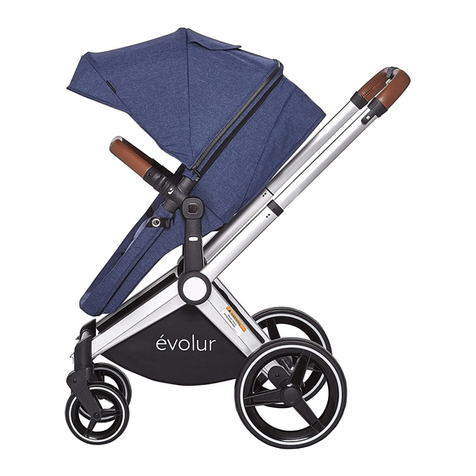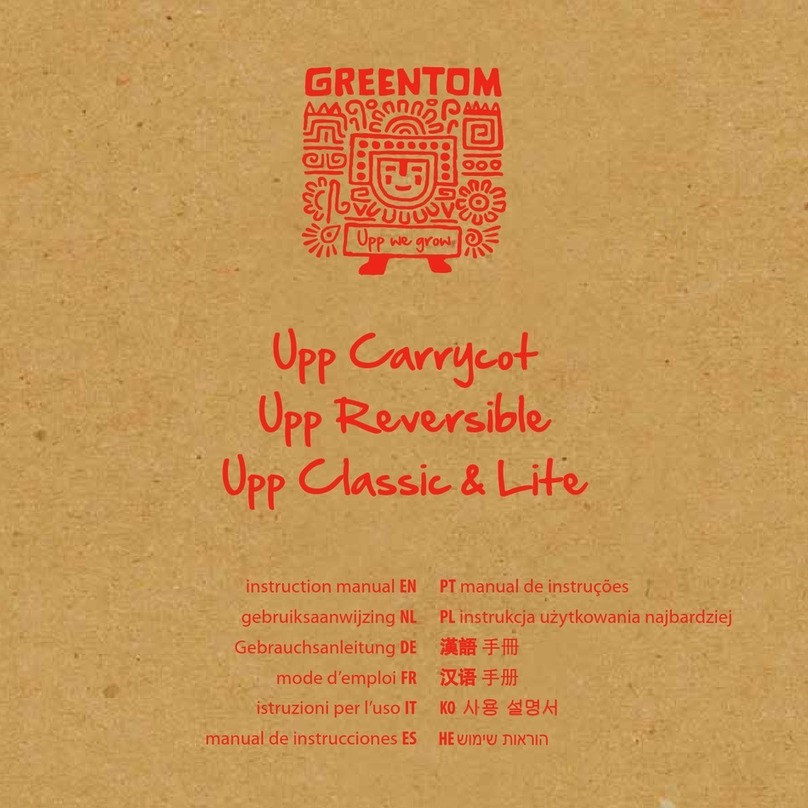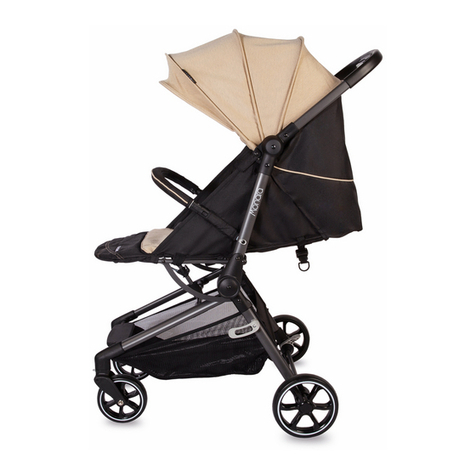MyWam Mouse User manual

Operation and maintenance manual
Edition 2 date 2021-05-10
Special stroller Mouse
A modern stroller with excellent driving characteristics

MOUSE Edition 2/2021-05-10
P a g e | 1
ATTENTION! Users with visual, reading or cognitive
impairment are requested to report to the
Manufacturer in order to obtain information in the
appropriate format.
Purpose of the Manual
The operation and maintenance manual contains basic information necessary for the correct use of the
Mouse stroller, including the principles of safe use, description of its construction, operation and
adjustment, preparation of the stroller for operation, how to maintain and clean the stroller, and
warranty conditions.
It is designed for people who directly care of children with disabilities (childcare assistants, parents,
guardians), which will be transported in a stroller. It is also intended for doctors and physiotherapists
operating the stroller.
ATTENTION! Before using the stroller, each User is obliged to read and act in accordance with its
guidelines
This manual is an integral part of the product and must always be attached to the product wherever
being sold. Keep this manual for future reference! Keep the manual in an easily accessible place. The
manual in the electronic version is available on the website www.mywam.eu.
ATTENTION! In the event of any medical incidents related to the presence of the Mouse wheelchair, the
Manufacturer must be immediately notified in writing by contacting it via registered letter or e-mail
with acknowledgment of receipt.
Manufacturer's contact details:
● Postal address: MyWam sp.j., ul. Szczecińska 10, 41-516 Chorzów, Poland
● contact phone number: +48 32 733 11 31
● e-mail address: [email protected]
User and maintenance manual version: EN Edition:2 Date: 2021-05-10
MyWam Kupiec, Bartold, Angres sp.j. reserves the right to make technical and commercial changes to the
content of the Operation and Maintenance Manual without prior notice. Each change will be determined
by the date the instructions were last updated.

MOUSE Edition 2/2021-05-10
P a g e | 2
Table of contents
1. PURPOSE AND INDICATIONS FOR THE USE OF THE MOUSE STROLLER 4
2. BASIC INFORMATION ABOUT THE MOUSE STROLLER 4
3. QUICK START 5
4. IMPORTANT INSTRUCTIONS AND SAFETY RULES 6
5. NAMEPLATE 7
6. WARNING LABELS 7
7. SYMBOLS DESIGNATION 7
8. GENERAL CONSTRUCTION OF THE STROLLER 7
9. CONFIGURATION AND USE – STROLLER FRAME 9
9.1 Frame folding mechanism 9
9.2 Unfolding the stroller frame. Transport lock. 9
9.3 Folding the frame 9
9.4 Swivel front wheels, solid. Locking the direction of travel of the front wheels 10
9.5 Rear wheels, solid. Installation and removal of rear wheels on the axle 10
9.6 Rear wheel amortization system 11
9.7 Ergonomic handle for pushing the stroller. Mechanism and angle adjustment of the handle 11
9.8 Central brake. Applying and deactivating the brake 11
9.9 Tilting foot 12
9.10 The transport handle 12
9.11 Footrest. Adjustment and use. 12
10. ASSEMBLY AND DISASSEMBLY OF THE SEAT TO THE FRAME 12
10.1. Assembly and disassembly of the seat to the frame 12
10.2. Adjustable seat, „reclining back” 13
10.3. Adjustable backrest 13
11. BASIC EQUIPMENT 13
11.1. Five-point belts 13
11.2. Safety barrier 14
11.3. Adjustable canopy with window 14
11.4. Shopping basket 14
11.5. Abduction and stabilizing belts 15
11.6. Wedge 15
11.7. Lininig pads 15
11.8. Upholstery 15
12. ACCESSORIES 15
12.1. Adjustable head supports - ↔ and ↕ 15
12.2. Adjustable chest and loin pads - ↔ and ↕ 15
12.3. Therapeutic table 16
12.4. Seat minimizing kit 16
12.5. Travel bag 17
12.6. Sun umbrella 17
12.7. Winter gloves 17
12.8. Winter sleeping bag 17
12.9. Mosquito net 17
12.10. Raincover 17
13. TECHNICAL SPECIFICATION OF THE MOUSE STROLLER 18
13.1. Material composition of the stroller 18

MOUSE Edition 2/2021-05-10
P a g e | 3
14. DELIVERY AND TOOLS 18
15. ASSEMBLY AND DISASSEMBLY OF THE STROLLER 19
16. PREPARATION FOR USE 19
17. USING THE STROLLER 20
17.1. Carrying the stroller 20
17.2. Getting on and off the stroller 20
17.3. Correct position in a stroller 20
17.4. Riding in a stroller 21
17.5. Moving on slopes 21
17.6. Overcoming thresholds or curbs 21
17.7. Transport in a car and other vehicles 21
17.8. Cleaning and care 21
18. STORAGE OF THE STROLLER 22
18.1. Preparation of the stroller for long-term storage 22
18.2. Corrosion protection 22
19. RE-USE 22
20. SERVICE AND PERIODIC INSPECTIONS 23
21. DISPOSAL 23
22. COMPLIANCE WITH REQUIREMENTS FOR MEDICAL DEVICES 24
23. NOTES 25
24. LIST OF AUTHORIZED SERVICE POINTS 26
25. WARRANTY CARD 27

MOUSE Edition 2/2021-05-10
P a g e | 4
Introduction
Thank you for purchasing Mouse special stroller for young people. We hope that it will be the cause
of many wonderful moments with your child and will be helpful every day. We make every effort to
ensure that our products meet your expectations and the highest standards. We encourage you to
contact our employees and follow us on our website www.mywam.eu and on social media. There you
can find out many interesting things about our products.
1. Purpose and indications for the use of the Mouse stroller
"Mouse" is a multifunctional wheelchair for disabled children. The stroller is based on a frame made
of aluminum and steel elements. It allows for quick removal of wheels. headrest, etc. The product is
equipped with a number of accessories improving the functionality and comfort of use, such as: table,
safety belts, wedge, hood, mosquito net, sleeping bag, shopping bag, etc. Users cannot drive the
wheelchair alone, but only with the help of a guardian. The trolley can be used indoors and outdoors, on
various surfaces (asphalt, concrete, stone, gravel) and in various weather conditions. Any other use of the
product than described is forbidden. The stroller must be used together with the instructions for use only
by adults caring for the user. Young people and children as well as any other persons without proper
training should not use the product.
The "Mouse" wheelchair is a medical device indicated for use by disabled children who, due to
their health condition, cannot walk or sit down on their own. The product is intended for the transport
and movement of the above persons in a sitting or lying position and for posture correction and this is its
intended use.
Clinical indications include cerebral palsy, meningeal hernia, dystrophies, paresis, etc.
The product is intended for users aged 2 to 6 years. The product should be used in accordance with
the recommendations of the attending physician or physiotherapist.
2. Basic information about the Mouse stroller
The Mouse youth stroller has many options, e.g.:
backrest angle adjustment see point 10.3
backrest and seat angle adjustment "Cradle" see point 10.2
seat depth adjustment - insert see point 12.4
footrest adjustment see point 9.11
torso stabilization see point 12.11 and 12.2
optional equipment see point 12

MOUSE Edition 2/2021-05-10
P a g e | 5
3. Quick start
To quickly use the stroller it must be unpacked and prepared for use according to item 15 Assembly and
disassembly of the stroller and item 16 Preparation for use. The following is a pictorial diagram, but it will
not replace careful reading of the complete manual.

MOUSE Edition 2/2021-05-10
P a g e | 6
Safety
4. Important instructions and safety rules
It is forbidden to use the stroller in a way for which the trolley is not dedicated.
The product contains small parts that can be dangerous if swallowed by a child!
Due to the large adjustment possibilities of the stroller, during the angular adjustment of the seat
and angular adjustment of the backrest, it is possible to set the position in which the child's head
is below the pelvic line. It is forbidden to use this position as it could lead to the risk of the child
choking.
It is forbidden to put additional weight on the trolley, especially when it comes to placing an
additional weight on the back of the backrest, e.g. a backpack or a bag. This may cause the Mouse
stroller to tip over and injure the user! It does not apply to original additional accessories dedicated
to the Mouse stroller that do not exceed the permissible load. All additional elements attached to
the stroller affect its stability.
ATTENTION! Depending on the adjustments made for the Mouse wheelchair - it concerns the
setting of the stroller's push handle, backrest height adjustment, backrest angular adjustment,
seat depth adjustment, seat angle adjustment, footrest angle adjustment and footrest adjustment
- this stroller may exceed the recommended dimensions.
ATTENTION! Each time the stroller is used, the steps listed below must be performed and the
stroller must not be used in the event of any irregularities. In such a situation, it is recommended
to urgently contact the Seller and the Manufacturer for advice.
ATTENTION! When driving through doors or similar restrictions restricting the direction of travel
of the stroller, make sure that there is adequate space on both sides of the stroller to prevent
pinching of hands or other body parts and to prevent damage to the stroller.
ATTENTION!
Never leave your child unattended in a stroller, as there is a risk of
injury and there is a risk of accident!
This product is not suitable for running, skating or roller-skating
This stroller is not intended as a seat in a motor vehicle
Beware of gaps and moving parts – risk of jamming
Do not carry the stroller with the child inside it
The stroller is packed in a plastic bag. The plastic bag is not a toy and
should be kept away from infants and young children as it may cause
suffocation when put on a head.
ATTENTION! It is forbidden to use the stroller if the technical condition of the stroller or a single
element of the stroller is bad or the user has any doubts about it, the stroller is damaged or
there is a suspicion that damage has occurred or if the operation of the stroller is not correct. In
such a situation, it is recommended to urgently contact the Seller and the Manufacturer for
advice.

MOUSE Edition 2/2021-05-10
P a g e | 7
5. Nameplate
The nameplate contains basic information about the product:
name, model, serial number (ID no.), maximum load,
manufactur date, CE mark and also certain warning in
accordance with the Operation and Maintenance Manual and
manufacturer's data (see Fig. 5.1).
The nameplate is located on the crossbeam at the rear of the
stroller frame, on its left side, glued from above
6. Warning labels
The warning label contains important warnings for the user
(see Fig. 6.1).
The warning label is located on the rear/side part of the
frame on both sides.
7. Symbols designation
Product serial number The manufacturer's name
Permitted total user
weight DESCRIPTION "WARNING!" and the
symbol in this manual are used to
enhance the reader's attention to the
content marked with this sign. Non-
compliance with content marked with
this description may endanger the
health and safety of the user and
accompanying people, and may also
damage the product.
Date of manufacture
Conformity assessment
mark according to
applicable European
regulations and directives
Warning about proceeding
in accordance with the
product Operation and
Maintenance Manual
8. General construction of the stroller
The specialist stroller Mouse consists of two main parts: frame and therapeutic seat with backrest.
Mouse offers a wide range of accessories that help to meet individual needs of the users.
The steal frame (Fig.4.1. ) with aluminium elements includes:
Adjustable, ergonomic handlebar (Fig.8.1.-nr 2)
Front swivel wheels (Fig.8.1.-nr12)
Front wheel direction lock (Fig.8.1.-nr15)
Fig. 5.1
Fig.. 6.1

MOUSE Edition 2/2021-05-10
P a g e | 8
Front wheel fork shock absorption system (Fig.8.1.-nr14)
Front wheel folding system (Fig.8.1.-nr13)
Rear wheels (Fig.8.1.-nr 8)
2-step rear wheel shock absorption system (Fig.8.1.-nr24)
Rear wheel folding (Fig.8.1.-nr23)
Central breake (Fig.8.1.-nr 9)
Shopping basket (Fig.8.1.-nr11)
hooks fixing seat to frame (Fig.8.1.-nr 6)
Transport lock (Fig.8.1.-nr 3)
Frame folding mechanism (upper and lower) (Fig.4.1.-nr 4)
rtyfrtuyrt
Reclining seat includes:
The seat is made of synthetic material
Side pad / reducer (Fig.8.1.-nr18)
Adjustable backrest (Fig.8.1.-nr5)
Safety barrier fixing (Fig.8.1.-nr7)
Safety barrier (Fig.8.1.-nr19)
5-point safty belts (Fig.8.1.-nr20)
Wedge (Fig.8.1.-nr17)
Adjustable head pads (Fig.8.1.-nr21)
Adjustable canopy with window (Fig.8.1.-nr1)
Adjustable and folding footrest (Fig.8.1.-nr16)
footrest extension (Fig.8.1.–nr22)
Optional inclination bar (Fig.8.1.-nr10)
Fig. 8.1
Main construction of the stroller

MOUSE Edition 2/2021-05-10
P a g e | 9
9. Configuration and use – stroller frame
9.1 Frame folding mechanism
The frame folding mechanism is located inside the frame and on the
frame in two places in its right part and in three places in its left part.
Describing these places from above, from the side of the handle to
push the stroller, these are:
right and left bend - an element that allowsfolding the upper
frame to reduce its dimensions
mechanism of folding the frame with a lock
9.2 Unfolding the stroller frame. Transport lock.
To unfold (open) the stroller frame: lay the stroller frame horizontally
on the ground and pull off the transport lock
(Fig. 9.2.1). Then gently pull the backrest to the
upright position (Fig. 9.2.2.). To set the stroller,
pull the handle carefully by lifting it slightly up
while bringing the stroller to the desired
position until the frame folding lock engages.
The frame of the stroller will not unfold
properly until the frame folding mechanism
has been properly closed. This is evidenced by
the clear "click" sound coming from the well-
closed mechanism of folding the frame.
9.3 Folding the frame
Description of the lower folding mechanism of the frame.
To fold the wheelchair frame: Lift the lever below the push handle on the right side of the frame and
simultaneously pull up both handles on the top of the folding mechanism. Then fold the stroller frame
and attach the transport lock. Photo 9.3.1.
Description of the upper folding mechanism of the frame.
To fold the wheelchair frame: Lift the lever below the push handle on the right side of the frame and
simultaneously pull up both handles on the top of the folding mechanism. Photo 9.3.2. Then fold the
stroller frame and attach the transport lock.
Fig. 9.2.1
Transport lock
Fig. 9.1.
Folding points
Fig. 9.2.2
Unfolding the frame
Fig. 9.3.1 Fig. 9.3.2
Lower mechanism Upper mechanism

MOUSE Edition 2/2021-05-10
P a g e | 10
9.4 Swivel front wheels, solid. Locking the direction of travel of the front
wheels
The used, durable wheels guarantee the highest quality of stroller driving, driving
pleasure and elegant appearance. The tires are tubeless, filled with a special gel
that has shock absorbing properties very similar to those of inflatable wheels.
The wheels are factory-fitted to the front wheel forks, which are finished with
top steering axles from above.
Both front wheels can be set for straight-ahead or unlocked for turning, which
makes it much easier to maneuver the stroller. Thanks to the locking of the
direction of travel of the front wheels and the possibility of putting it on or taking
off, there is clearly greater comfort for both the child and the assistant when
driving the stroller.
It is recommended to remove the lock and allow the front wheels to turn while
driving the stroller on a completely smooth surface, e.g. in shopping centers,
school.
Assembly. To attach the wheels, insert the wheel axle into the folding
system slot until you hear a ‘click’. The audible clicking sound is the indication
that the assembly has been done properly. For dismantling the front wheels
press the button on the front wheel folding system (Fig. 9.4.1 ) and eject the
wheel axle from the front wheel folding system slot.
Direction lock. In the event of uneven surfaces, moving on sloping surfaces,
when crossing thresholds or curbs, it is recommended to install the lock and
block the turning of the front wheels. To block the front wheels, turn the lock
knob left. Turn the lock knob right, to unlock. (Fig.9.4.2)
9.5 Rear wheels, solid. Installation and removal of rear wheels on the axle
The used, durable wheels guarantee the highest quality of stroller driving, driving pleasure and elegant
appearance. The tires are tubeless, filled with a special gel that has shock absorbing properties very similar
to those of inflatable wheels.
Thanks to the possibility of dismounting both the wheels and their axle, the trolley is smaller after folding,
which facilitates its transport and storage.
The wheel assembly mechanism is mounted inside the rear wheels and ensures quick assembly and
disassembly of the rear wheels. It is started by pressing the quick assembly clamp (Fig. 9.6.1) towards the
center of the wheel, after which the rear wheel can be mounted on the rear wheel axle or the rear
wheel can be removed from the rear wheel axle.
Assembly. When installing the rear wheel on the rear wheel axle, press the clamp in the center of
the wheel and put the wheel on the beginning of its axle. Then stop pressing the clamp and continue
sliding the wheel onto its axle until it clicks.
The correct wheel placement is demonstrated
by the clear "click" sound coming from the
quick axle rear axle mounting mechanism.
Dismantling the wheels from the axle.
In order to remove the rear wheel from the
rear wheel axle, press the clamp in the middle
of the wheel and slide the wheel out of its axle.
– Fig 9.5.2.
Fig 9.4.1
Quick release button
Fig 9.4.2
Direction lock knob
Fig 9.5.1 Fig 9.5.2
Quick mount buckle Wheel disassemble

MOUSE Edition 2/2021-05-10
P a g e | 11
9.6 Rear wheel amortization system
The stroller is equipped with spring-loaded cushioning of the frame
and rear wheels, located at the ends of the rear legs of the frame,
when in contact with the crossbeam. Amortization works
automatically. The adjustment is done by activating the up-down
lever located from the bottom of the shock absorber. In order to
facilitate the switchover of settings by the lever, simultaneous
pressure on the shock absorber spring is allowed. When the lever is
shifted, the shock absorber spring will be compressed (option for
hard ground) or extended (soft ground).
9.7 Ergonomic handle for pushing the stroller. Mechanism
and angle adjustment of the handle
The handle is used to push the stroller, providing a firm grip in
various driving conditions. It has the ability to adjust the height of
the handle for the child's assistant who drives the stroller - Fig. 9.7
Adjustment mechanism. These are two buttons on the
outside of the frame, located on the joints of the handle to push the
stroller.
Angle adjustment of the stroller push handle. To change the
angle of the stroller push handle, push both buttons of the angle
adjustment mechanism of the push handle and change its angle.
After setting the handle in the correct position, stop pressing the
buttons, which will automatically lock the push handle in the desired
position.
9.8 Central brake. Applying and deactivating the brake
The central brake pedal (Fig. 9.8), which when pressed blocks the two rear wheels of the stroller
directly, is located in the middle of the crossbeam, at the rear of the stroller frame.
Central brake on and off
To apply the central brake, press the brake pedal down towards the ground until it clicks. The correct
activation of the brake is indicated by a clear "click" sound from the central brake. To disengage the
central brake, pull the brake pedal up.
Fig 9.6
Wheel amortization system
Fig 9.7
Handle angular adjustment
Fig 9.8
Central brake
Fig 9.9
Tilting foot

MOUSE Edition 2/2021-05-10
P a g e | 12
9.9 Tilting foot
The tilting foot (Fig. 9.9) is located on the right side of the
crossbeam, at the rear of the stroller frame. In order to use it,
press the tilting foot and at the same time pull the handle to push
the stroller, which in turn will cause the front of the stroller to
rise up together with the front wheels. Using the tilting foot
makes it easier for the stroller to climb onto small steps or curbs.
9.10 The transport handle
The transport handle is located on the shopping basket upper
fastening (Fig. 9.10)
9.11 Footrest. Adjustment and use.
W In order to change the inclination of the footrest, press the buttons marked on the picture on
both sides of the footrest, then set the appropriate position and release the buttons (Fig. 9.11.1)
In order to change the height of the footrest, unscrew the bolts fixing the footrest and pull the
footrest from the angle controllers. In
place of the footrest, 2 tubes should be
installed and bolts tightened. The
footrest should be inserted into the
tube so that an additional 3 heights of
the footrest are obtained (Fig. 9.11.2).
The footrest is equipped with straps
that fasten the child's feet. It is
recommended to put them on while
using the stroller.
10. Assembly and disassembly of the seat to the frame
10.1. Assembly and disassembly of the seat to the frame
The two frame hooks that are attached to the seat are very important parts of the stroller. They serve the
purpose of attaching the seat to the stroller’s frame. The proper use of the hooks is essential for the safety
of the child as well as that of other people. Make sure there aren’t any cracks and damage in the stroller’s
frame. Also, check if it works properly. Do not use the stroller in case of any suspicion as to the proper
operation of the stroller. Keep the safety of your child in mind at all times.
Seat assembly. The seat can
face the front or the back. To install the
seat, place it on the stroller’s frame
hooks. Press until you hear a ’click’
twice. Fig 10.1.1.
Dismantling the seat. To
dismantle the seat, press two colorful
buttons situated on the lower part of
the stroller’s frame hooks. Next, eject
the seat from the frame hooks. Fig
10.1.2.
Fig 9.10
Transport handle
Fig. 10.1.1 Fig. 10.1.2
Hooks for mounting the seat Seat release button
Fig. 9.11.1 Fig.. 9.11.2.
Tilt buttons Screws and extensions

MOUSE Edition 2/2021-05-10
P a g e | 13
10.2. Adjustable seat, „reclining back”
T he stroller has a seat that can be adjusted to four different
positions including a bassinet position. To change the position,
pull back the steel handle at the back of the seat and slowly
change the position of the seat. After securing the desired
position, let go of the handle.
Caution! Each change of the seat position alters the general center
of gravity, which impacts the stability of the stroller.
Caution! Never leave your child in the stroller while making
adjustments! It can put your child in danger.
10.3. Adjustable backrest
The stroller’s backrest can be adjusted to various positions varying from a seating position to a lying
position. To change the position, move the backrest towards a seating position first. Then, pull the
handle located at the back of the backrest and change the position slowly. After reaching the desired
position, pull the handle down.
Caution! Each change of the backrest position requires an adjustment of the 5-point belts.
Caution! Never leave your child in the stroller while making adjustments! It can put your child in danger.
Caution! Adjustments must be made with the brake engaged.
11. Basic equipment
11.1. Five-point belts
The Mouse stroller is standard equipped with professional five-point seat
belts
Five-point belts adjustment. Adjust the five-point belts to your child
before attaching them. To adjust the length of the belts, move the adjusters
on the braces up or down and move the protectors accordingly. To adjust the
height of the braces to be attached to the backrest, move the braces from
low to high, or vice versa.
Use. In order to put on the child five-point belts, put the braces on
the right and left of the child and then attach both braces to the belt buckle,
which is fixed on the seat. In order to remove five-point belts from a child,
press the button on the buckles and remove both braces from the buckle and
slowly remove these braces from the right and left side of the child.
Attention! Each change in the angle of the backrest requires a readjustment of the five-point belt length.
Fig 10.3
Reclining back handle
Fig. 10.2
Adjustable seat
Fig 11.1.
Five-point belts

MOUSE Edition 2/2021-05-10
P a g e | 14
11.2. Safety barrier
The Mouse stroller can be equipped with a safety barrier that
prevents the sitting child from falling forward in certain indications..
The safety barrier is mounted with the same fixings as the
therapeutic table, so you cannot use both of these elements at the
same time. To fastening the safety barrier to the frame slide it into the
attachment tubes and listen for the ‘click’. The clearly audible ‘click’ is
an indication that the barrier has been securely attached to the seat.
To disassemble the barrier pull both barrier latches on the frame and
pull out the barrier at the same time.
11.3. Adjustable canopy with window
The Mouse stroller can be equipped with an adjustable canopy
with a window that helps protect the child from the sun or rain. The
elements of the canopy are: canopy frame (front and rear arch),
canopy opening adjustment mechanism (right and left), two snaps
with red buttons fastening the canopy to the frame, canopy
upholstery, and a mosquito net with a zipper.
Assembly. The fastening of the adjustable canopy with the window
are two plastic elements located on the outer sides of the upper part
of the backrest. These attachments are used to mount the canopy with
the window.
To install the adjustable canopy with the window, place the backrest
upright, and then slide both canopy latches into the backrest mounts
in parallel. Mount the canopy in such a way that the upholstery at the
back/bottom of the canopy overlaps the back of the stroller. In addition, make sure that the canopy
adjustment element is secured with upholstery inside. This can be done by stretching the upholstery
and placing the loop on the button in the corner of the canopy.
Disassembly. To disassemble the adjustable canopy with window, press the two red buttons on
the roof fixing latches and slide the latches out of the backrest mounts.
Use. To change the size of the canopy, hold the front arch and the rear arch of the canopy frame
and bring the arches closer or closer to each other to set the desired position. The canopy surface
adjustment mechanism latches automatically. A special feature of the
canopy is a window with a mosquito net for ventilation. The window
opens and closes with a zipper.
11.4. Shopping basket
The Mouse stroller can be equipped with a shopping basket which is
used to transport small, ordinary items of everyday life, resistant to
shocks, impacts, bruises, soaking, flooding and dirt.
It is mounted at the bottom of the stroller by wrapping it on the
frame of the stroller and fastening it with a zipper.
The maximum load of the shopping basket is 3 kg.
Fig 11.2
Safety barrier
Fig 11.3
Adjustable canopy
Fig 11.4
Shopping basket

MOUSE Edition 2/2021-05-10
P a g e | 15
11.5. Abduction and stabilizing belts
Abduction and stabilizing belts are used for additional pelvic
stability and prevent the child from slipping out of the stroller.
The correct way to use them is to fasten the child's thighs so
that his pelvis adheres as close as possible to the backrest. This
will ensure a healthier and more comfortable position of the
child in the stroller.
Adjustment. To adjust the length of the Abduction and
stabilizing belts, you must move the adjusters on the front belt
straps up or down.
Use. In order to put the child on the Abduction and
stabilizing belts, put the child on the installed belts, then wrap the
child's leg and fasten both belt buckles to both front straps. In
order to remove the Abduction and stabilizing belts from the
child, unfasten both belt buckles from the front straps.
11.6. Wedge
The Mouse stroller can be equipped with a wedge which in the case of
specific indications provides discharge (inclination to the sides) of the
child's lower limbs from his body. The wedge has a two-stage
adjustment level. Fig.11.6
11.7. Lininig pads
The Mouse stroller is equipped with
lining pads, securing the velcro on the
trolley's backrest, if no additional
equipment is installed. Fig 11.7.
11.8. Upholstery
The Mouse stroller is equipped with upholstery, which is completely
removed for cleaning. To do this, detach all the elements fastening it to
the stroller frame. How to clean the upholstery is described in point
17.8. Cleaning and care.
12. Accessories
12.1. Adjustable head supports - ↔ and ↕
To adjust the head support, draw aside the seat upholstery on the front
and back of the seat. Next, take off the head support knobs, which are
situated on the back of the seat and adjust the head supports at the front
of the seat. That accomplished, screw the knobs back in the appropriate
place at the back of the seat. Finally, draw the upholstery at front and
back of the seat. Fig 12.1
12.2. Adjustable chest and loin pads - ↔ and ↕
To adjust the chest and loin pads, draw aside the seat upholstery on the
front (Fig 12.2.1) and back of the seat (Fig 12.2.2). Next, take off the chest
Fig 11.5
Abduction and stabilizing belts
Fig 11.6
Wedge
Fig 11.7
Lining pads
Fig 12.1
Side pads

MOUSE Edition 2/2021-05-10
P a g e | 16
and loin pads knobs, which are situated on the back of the seat (Fig 12.2.3) and adjust the chest and loin
pads at the front of the seat. That accomplished, screw the knobs back in the appropriate place at the
back of the seat. Finally, draw the upholstery at front and back of the seat. (Fig 12.2.4)
Fig 12.2.1 Fig 12.2.2 Fig 12.2.3 Fig 12.2.4
Unfasten the upholstery at both sides / Release the knobs / Fasten the upholstery
12.3. Therapeutic table
The Mouse stroller can be equipped with a non-slip therapeutic
table with a maximum load of 3kg. – Fig.12.3.
The therapeutic table is mounted with the same fixings as the safety
barrier so you cannot use both of these elements at the same time.
Slide the table into the attachment tubes and listen for the ‘click’. To
assemble the table, slide them onto the frame, latch. The table will
not be properly installed until the latch engages the frame and
snaps into place. This is evidenced by the clear "click" sound coming
from a well-connected therapeutic table mount. To disassemble the
table, pull both latches on the frame and pull out the table at the
same time.
Caution! The horizontal arrangement of the table may change with
the adjustment of the cradle and thus items placed on the table
must be secured.
12.4. Seat minimizing kit
The Mouse stroller is equipped with an insert (Fig. 12.4). It is used to
minimize the inside dimensions of the seat width and depth. The
upholstery of the seat minimizing kit is removable thanks to the
zipper sewn in, which allows it to be replaced or cleaned.
Assembly. The insert is installed anywhere in the stroller, at
any height adapting to the patient's indications. Installation is done
with Velcro on the back side of the insert.
Disassembly is done by removing the element - pulling the
velcro from the stroller upholstery.
Fig 12.3
Therapeutic table
Fig 12.4
Seat minimizing kit

MOUSE Edition 2/2021-05-10
P a g e | 17
12.5. Travel bag
The large and elegant travel bag is mounted on two handles on the inside of
the handle to push the stroller (see Fig. 12.5). The maximum bag load is 2kg.
12.6. Sun umbrella
The Mouse stroller can be equipped with a Sun umbrella (see Fig. 12.6) that
helps protect the child from the sun.
12.7. Winter gloves
Two winter gloves that increase the comfort of a child's assistant during
colder weather can be put on the handle to push the stroller (see Fig.12.7).
First you need to put on two material clamps and fasten them with velcro on
the handle to push the stroller, then gloves are put on these material clamps
and fastened with snaps.
12.8. Winter sleeping bag
The ewa stroller can be equipped with a Winter sleeping bag, increasing the
child's comfort during colder weather (Fig. 12.8). This optional equipment
requires installation to other optional equipment - a barrier. To mount the
Winter sleeping bag, place it on the footrest from below, and transfer it
through the safety barrier from above and fasten it with snaps to the frame
of the stroller.
12.9. Mosquito net
The Mouse stroller can be equipped with a mosquito net (see Fig. 12.9),
which prevents insects from coming into direct contact with the child. This
additional accessory requires fitting to other optional equipment. In order to
mount the mosquito net, put it from above on the entire adjustable canopy with window, and then
cover the mosquito net seat and footrest.
12.10. Raincover
The Mouse stroller can be equipped with a rain cover that helps protect the child from moisture. This
optional equipment requires mounting to other optional equipment. To mount the rain cover, put it on
top of the entire adjustable canopy with window and then cover the seat and footrest with the cover
(see Fig. 12.10).
Fig 12.8 Fig 12.9 Fig 12.10
Winter sleeping bag Mosquito net Raincover
Fig 12.5
Travel bag
Fig 12.6
Sun umbrella
Fig 12.7
Winter gloves

MOUSE Edition 2/2021-05-10
P a g e | 18
13. Technical specification of the Mouse stroller
length of the stroller 95-124 cm
the width of the stroller 60 cm
the height of the stroller 122 - 134 cm
total weight 17,2 - 23,2kg
effective seat depth 22* / 26 cm
seat width 24* / 32 cm
backrest height 52 cm
backrest width 30 cm
distance between footrest and the seat / number
of adjustmentsi 14,5-23 cm / 4 positions
length of the stroller, folded up for transport frame 84 cm /seat 72 cm
width of the stroller, folded up for transport frame 58 cm /seat 42 cm
hight of the stroller, folded up for transport frame 25 cm /seat 39 cm
capacity of the shopping basket 5 kg
carrying capacity of a tourist bag 2 kg
max. patient weight 30 kg
patient height 80 - 110 cm
seat plane angle / number of adjustments 8°-23°/ 4 positions
backrest angle / number of adjustments 16°-88° / 4 positions + lying position
footrest angle / number of adjustment ok 84°-173° / 6 positions
COMMENTS
*) values shown with inserts
Measurement value tolerance +/- 20mm, +/- 1.5kg, +/- 1 °
The manufacturer reserves the right to introduce changes to the technical parameters
13.1. Material composition of the stroller
Powder coated steel and aluminium, fabrics 100% polyester and plastic (PP, PCV, ABS, PA, PE, PU).
14. Delivery and tools
The Mouse stroller is delivered in a cardboard box and pre-assembled. The original packaging should
contain the following items:
Folded stroller frame with seat, backrest and wheels
Optional equipment as ordered
User manual with warranty card
Before use, check and make sure that the carton contains all the elements and none of them has been
damaged, e.g. during transport. In the event that it is found that in the carton received is missing or
damaged any component, contact the Seller and the Manufacturer in order to receive the missing
elements or replace the product with a new, fully complete and functional.
The multifunctionality and extensive equipment of the Mouse stroller allow you to tailor the stroller to
your personal requirements. To do this, read the entire manual carefully before use.
No tools are required to assemble and disassemble the Mouse stroller.
A Phillips screwdriver is required to adjust the height of the footrest. An Allen key is needed to adjust
the backrest height and seat depth.

MOUSE Edition 2/2021-05-10
P a g e | 19
15. Assembly and disassembly of the stroller
Stroller assembly. The product pre-packed in the original carton is already pre-assembled.
Complete the installation by completing the following steps:
a) mount the rear wheels on the axle
b) unfold the stroller frame with a footrest adjusting the parameters:
o enable/disable lock of the direction of travel of the front wheels
o adjust the height and angle of the stroller push handle
o adjust the seat tilt angle
o set the tilt angle of the backrest
o adjust the length of the five-point belts
o adjust the height of the footrest and the tilt angle of the footrest
c) install appropriate accessories and adjust parameters, for example:
o adjust the usable width and depth of the seat (set minimizing kit)
o install a safety barrier or a therapeutic table
o adjust the deflection and stabilization belts
o adjust the canopy with the window
o install and adjust the wedge
o put on a travel bag
o put on a shopping basket
o put on selected items of equipment dedicated to the seasons: winter sleeping bag,
winter gloves, mosquito net, raincover, umbrella
Dismantling the stroller. In order to dismantle the stroller, it is necessary to:
a) remove the optional equipment
b) unclip the seat from the frame of the stroller
c) lock the front wheels, fold the footrest and stroller frame
d) unclip the rear and front wheels
e) fold in the stroller closing it with the transport lock.
16. Preparation for use
Before using the stroller:
o Check the good technical condition of the trolley and all its elements, and if the technical condition
of the trolley or its single element is bad or the user has any doubts about it, then the trolley must
not be used. Please contact the Seller and the Manufacturer.
o Check that the wheelchair frame has been folded out correctly and that the folding mechanism
has been properly closed (locked).
o Check that the seat is correctly attached to the stroller frame
o Check that all four wheels are properly installed and that the tread tires are in good condition on
all four wheels.
o Check that the central brake is working properly and apply the brake.
o Correctly make all regulations and adjust the stroller to the child's needs, including setting the
appropriate depth of the therapeutic seat and the height of the backrest, appropriate inclination
of the therapeutic seat and backrest inclination, set the appropriate inclination of the footrest,
adjust the appropriate tension of the belts on the backrest and on the seat, check the length of
the five-point belts. Check that all adjustments are properly seated and secured.
o Check if the trolley upholstery is dry.
Other manuals for Mouse
1
Table of contents
Other MyWam Stroller manuals
